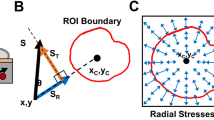Abstract
Introduction
Trophoblast cells in vivo form a 3-dimensional structure that promotes complex cell-to-cell interactions that cannot be studied with traditional monolayer culture. We describe a 3-dimensional trophoblast bioreactor to study cellular interactions.
Methods
Nonadhesive agarose hydrogels were cast from molds using computer-assisted prototyping. Trophoblast cells were seeded into the gels for 10 days. Morphology, viability, and vesicle behavior were assessed.
Results
Trophoblast cells formed uniform spheroids. Serial sectioning on days 3, 7, and 10 revealed central vacuolization with a consistent outer rim 12.3-µ thick. The vesicle configuration has been confirmed with confocal imaging. Electron Microscopic (EM) imaging revealed its ultrastructure. The vesicles migrate across a fibronectin-coated surface and invaded basement membrane.
Conclusions
Trophoblast cells cultured in a novel substrate-free 3-dimensional system form trophoblast vesicles. This new cell culture technique allows us to better study placental cell-to-cell interactions with the potential of forming microtissues.
Similar content being viewed by others
References
Veeck L, Zaninovic N. An Atlas of Human Blastocysts. New York, NY: The Parthenon Publishing Group; 2003.
Graham CH, Lala PK. Mechanisms of palcental invasion of the uteris and their control. Biochem Cell Biol. 1992;70(10–11):867–874.
Conley AJ, Mason JL. Placental steroid hormones. Baillieres Clin Endocrinol Metab. 1990;4(2):249–272.
Napolitano AP, Chai P, Dean DM, Morgan JR. Dynamics of the self-assembly of complex cellular aggregates on micromolded nonadhesive hydrogels. Tissue Eng. 2007;13(8):2087–2094.
Lewis MP, Clements M, Takeda S, et al. Partial characterization of an immortalized human trophoblast cell-line, TCL-1, Which possesses a CSF-1 auotcrine loop. Placenta. 1996;17(2–3):137–146.
Lynch MJ, Raphael SS, Mellor LD, Spare PD, Inwood MJ. Medical Laboratory Technology and Clinical Pathology.2nd ed. Philadelphia: WB Saunders Co; 1969.
Stachecki JJ, Yelian FD, Leach RE, Armant DR. Mouse blastocyst outgrowth and implantation rates following exposure to ethanol or A23187 during culture in vitro. J Reprod Fertil. 1994;101(3):611–617.
Kelm JM, Ehler E, Nielsen LK, Schlatter S, Perriard JC, Fussenegger M. Design of artificial myocardial microtissues. Tissue Eng. 2004;10(1–2):201–214.
Dean DM, Napolitano AP, Youssef J, Morgan JR. Rods, tori, and honeycombs: the directed self-assembly of microtissues with prescribed microscale geometries. FASEB J. 2007;21(14):4005–4012.
Abbott A. Cell culture: biology’s new dimension. Nature. 2003;424(6951):870–872.
Yamashita Y, Shimada M, Tsujita E, et al. High metabolic function of primary human and porcine hepatocytes in a polyurethane foam/spheroid culture system in plasma from patients with fulminant hepatic failure. Cell Transplant. 2002;11(4):379–384.
Blan NR, Birla RK. Design and fabrication of heart muscle using scaffold-based tissue engineering. J Biomed Mater Res A. 2008;86(1):195–208.
Bartholomä P, Gorjup E, Monz D, Reininger-Mack A, Thielecke H, Robitzki A. Three-dimensional in vitro reaggregates of embryonic cardiomyocytes: a potential model system for monitoring effects of bioactive agents. J Biomol Screen. 2005;10(8):814–822.
LaMarca HL, Ott CM, Bentrup KH, et al. Three-dimensional growth of extravillous cytotrophoblasts promotes differentiation and invasion. Placenta. 2005;26:709–720.
Foty RA, Steinberg MS. The differential adhesion hypothesis: a direct evaluation. Dev Biol. 2005;278(1):255–266.
Kidder GM, Watson AJ. Roles of Na, K-ATPase in early development and trophectoderm differentiation. Semin Nephrol. 2005;25(5):352–325.
Cereijido M, Contreras RG, Shoshani L, Flores-Benitez D, Larre I. Tight junction and polarity interaction in the transporting epithelial phenotype. Biochim Biophys Acta. 2008;1778(3):770–793.
Eckert JJ, Fleming TP. Tight junction biogenesis during early development. Biochim Biophys Acta. 2008;1778(3):717–728.
Korff T, Krauss T, Augustin HG. Three-dimensional spheroidal culture of cytotrophoblast cells mimics the phenotype and differentiation of cytotrophoblasts from normal and prreclamptic pregnancies. Exp Cell Res. 2004;297(2):415–423.
Bischof P, Campana A. Molecular mediators of implantation. Baillieres Best Pract Res Clin Obstet Gynaecol. 2000;14(5):801–814.
Armant DR, Kaplan HA, Lennarz WJ. Fibronectin and laminin promote in vitro attachment and outgrowth of mouse blastocysts. Dev Biol. 1986;116(2):519–523.
Morrish DW, Dakour J, Li H. Functional regulation of human trophoblast differentiation. J Reprod Immunol. 1998;39(1–2):179–195.
Niwa H, Toyooka Y, Shimosato D, et al. Interaction between Oct3/4 and Cdx2 determines trophectoderm differentiation. Cell. 2005;123(5):917–929.
Jollie WP. Development, morphology, and function of the yolk-sac placenta of laboratory rodents. Teratology. 1990;41(4):361–381.
Carter AM. Animal models of human placentation—a review. Placenta. 2007;28(suppl A):S41–S47.
Author information
Authors and Affiliations
Corresponding author
Rights and permissions
About this article
Cite this article
Robins, J.C., Morgan, J.R., Krueger, P. et al. Bioengineering Anembryonic Human Trophoblast Vesicles. Reprod. Sci. 18, 128–135 (2011). https://doi.org/10.1177/1933719110381923
Published:
Issue Date:
DOI: https://doi.org/10.1177/1933719110381923




